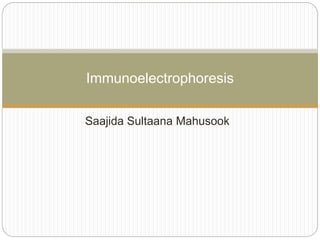Immunoelectrophoresis
•Als PPTX, PDF herunterladen•
81 gefällt mir•53,688 views
Immunoelectrophoresis-principle-procedure-Result-Applicaton
Melden
Teilen
Melden
Teilen

Empfohlen
Empfohlen
Weitere ähnliche Inhalte
Was ist angesagt?
Was ist angesagt? (20)
Ouchterlony double diffusion and Radial immunodifusion

Ouchterlony double diffusion and Radial immunodifusion
Ähnlich wie Immunoelectrophoresis
Ähnlich wie Immunoelectrophoresis (20)
Usage of Immunological reactions in diagnostics of infectious diseases. 

Usage of Immunological reactions in diagnostics of infectious diseases.
Mehr von Saajida Sultaana
Mehr von Saajida Sultaana (20)
Adaptation of microorganism in environment- microbial ecology

Adaptation of microorganism in environment- microbial ecology
Virus- characteristics and viral infections infograph 

Virus- characteristics and viral infections infograph
Food microbiology - mold: morphological, cultural, physiological characteristics

Food microbiology - mold: morphological, cultural, physiological characteristics
Food microbiology- cultural, morphological and physiological characters of yeast

Food microbiology- cultural, morphological and physiological characters of yeast
Kürzlich hochgeladen
Kürzlich hochgeladen (20)
Food safety_Challenges food safety laboratories_.pdf

Food safety_Challenges food safety laboratories_.pdf
NO1 Top Black Magic Specialist In Lahore Black magic In Pakistan Kala Ilam Ex...

NO1 Top Black Magic Specialist In Lahore Black magic In Pakistan Kala Ilam Ex...
Plant propagation: Sexual and Asexual propapagation.pptx

Plant propagation: Sexual and Asexual propapagation.pptx
UGC NET Paper 1 Mathematical Reasoning & Aptitude.pdf

UGC NET Paper 1 Mathematical Reasoning & Aptitude.pdf
Exploring_the_Narrative_Style_of_Amitav_Ghoshs_Gun_Island.pptx

Exploring_the_Narrative_Style_of_Amitav_Ghoshs_Gun_Island.pptx
Fostering Friendships - Enhancing Social Bonds in the Classroom

Fostering Friendships - Enhancing Social Bonds in the Classroom
On National Teacher Day, meet the 2024-25 Kenan Fellows

On National Teacher Day, meet the 2024-25 Kenan Fellows
Unit 3 Emotional Intelligence and Spiritual Intelligence.pdf

Unit 3 Emotional Intelligence and Spiritual Intelligence.pdf
Python Notes for mca i year students osmania university.docx

Python Notes for mca i year students osmania university.docx
Immunoelectrophoresis
- 2. Immunoelectrophoresis refers to precipitation in agar under an electric field. It is a process of combination of immuno-diffusion and electrophoresis. An antigen mixture is first separated into its component parts by electrophoresis and then tested by double immuno-diffusion. Antigens are placed into wells cut in a gel (without antibody) and electrophoresed. A trough is then cut in the gel into which antibodies are placed. The antibodies diffuse laterally to meet diffusing antigen, and lattice formation and precipitation occur permitting determination of the nature of the antigens. The term “immunoelectrophoresis” was first coined by Grabar and Williams in 1953.
- 3. Principle When electric current is applied to a slide layered with gel, antigen mixture placed in wells is separated into individual antigen components according to their charge and size. Following electrophoresis, the separated antigens are reacted with specific antisera placed in troughs parallel to the electrophoretic migration and diffusion is allowed to occur. Antiserum present in the trough moves toward the antigen components resulting in formation of separate precipitin lines in 18-24 hrs, each indicating reaction between individual proteins with its antibody.
- 5. Procedure Agarose gel is prepared on a glass slide put in a horizontal position. Using sample template, wells are borne on the application zone carefully. The sample is diluted 2:3 with protein diluent solution (20μl antigen solution +10 μl diluent). Using a 5 μl pipette, 5 μl of control and sample is applied across each corresponding slit (Control slit and Sample slit). The gel is placed into the electrophoresis chamber with the samples on the cathode side, and electrophoresis run for 20 mins/ 100 volts. After electrophoresis completes, 20 μl of the corresponding antiserum is added to troughs in moist chamber and incubated for 18- 20 hours at room temperature on a horizontal position. The agarose gel is placed on a horizontal position, and dried with blotter sheets. The gel in saline solution is soaked for 10 minutes and the drying and washing repeated twice again. The gel is dried at a temperature less than 70°C and may be stained with
- 6. Results Presence of elliptical precipitin arcs represents antigen- antibody interaction. Absence of formation of precipitate suggests no reaction. Different antigens (proteins) can be identified based on the intensity, shape, and position of the precipitation lines.
- 7. Applications The test helps in identification and approximate quantization of various proteins present in the serum,in protein identification and in immunology. Immunoelectrophoresis is used in patients with suspected monoclonal and polyclonal gammopathies. The method is used to detect normal as well as abnormal proteins, such as myeloma proteins in human serum. Used to analyze complex protein mixtures containing different antigens. The medical diagnostic use is of value where certain proteins are suspected of being absent (e.g., hypogammaglobulinemia) or overproduced (e.g., multiple myeloma). This method is useful to monitor antigen and antigen-antibody purity and to identify a single antigen in a mixture of antigens.